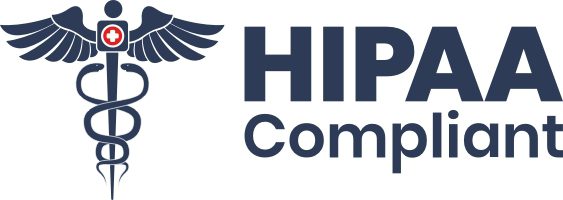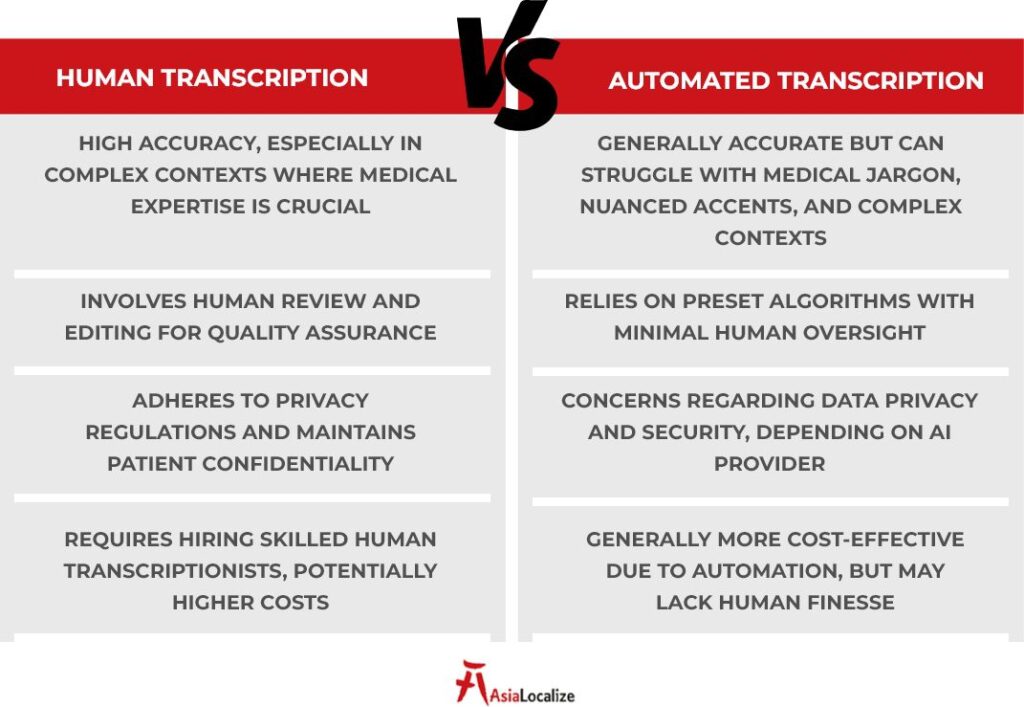As the demand for quality healthcare services increases worldwide, the role of medical transcription is crucial to maintaining a meticulous record of clinical interactions, procedures, and diagnoses. However, with healthcare and medical settings becoming multilingual more than ever and medical staff and patients hailing from various linguistic backgrounds, finding the best medical transcription services is imperative.
But what makes the best medical transcription services? In this blog, we’ll explore the significance of medical transcription services and how they impact patient care and overall healthcare outcomes.
What is Medical Transcription?
Medical transcription is the process of converting audio recordings or spoken speech into written or electronic format. It’s a critical process in healthcare and medical settings and helps create accurate and accessible records that support effective communication, patient care, and legal documentation. While medical transcription, just as any type of transcription, requires a set of skills, there are expertise and competencies specific to the unique nature and demands of the medical field.
Things like language proficiency as well as exceptional listening and communication skills come in as a common component (and priority) in all types of transcription.
However, medical transcription, and the best medical transcription services, in particular, requires profound medical expertise. An umbrella term for the range of skills and expertise required to deliver high-quality medical transcription.
So what does this include?
When it comes to medical transcription, a solid understanding of medical terminology, anatomy, pharmacology, medical procedures, and diagnoses can’t be overlooked.
But, the medical field encompasses a wide spectrum of specialties, each with its own language and practices, from neurology to gynecology.
That’s why you’ll need transcriptionists with expertise in specific medical specialties, depending on your needs. They must be well-versed in their specialized medical vocabulary as well as a deep understanding of medical procedures and equipment. This way, they can precisely capture the intricacies of each field and produce accurate documentation in a relevant medical context.
What’s more, medical transcription is governed by a rigorous regulatory framework to adhere to ethical practices and patient privacy regulations, such as the Health Insurance Portability and Accountability Act (HIPAA).

During transcription, medical transcriptionists encounter sensitive information, ethical dilemmas, and cases involving patient confidentiality. They need to understand and adhere to these HIPAA regulations to maintain the confidentiality of sensitive patients’ personal and medical information.
The Role of Medical Transcription
The importance of medical transcription cannot be overstated. It plays a critical role in ensuring the accuracy and safety of patient care, as well as in facilitating medical research and advancing healthcare as a whole. As such, it is essential that healthcare professionals and organizations prioritize the accuracy and quality of their medical transcription practices.
More Efficient Collaboration and Patient Care
Medical transcription allows for easier sharing of patient data between different medical facilities and providers, which can be particularly important in emergencies. This not only helps ensure better communication but helps professionals make informed decisions about patient well-being, which improves patient care.
Faster and More Accurate Diagnosis
Medical transcription plays a vital role in helping doctors diagnose diseases accurately and faster. Additionally, it helps to minimize errors and misunderstandings that can occur when notes are misinterpreted or misread, ensuring that patients receive the proper treatment as soon as possible.
Legal Purposes
As we stated before, medical transcription helps maintain accurate records of a patient’s medical history and treatment. These records can be used as evidence in legal proceedings, such as medical malpractice lawsuits, and protect medical professionals and practitioners from legal disputes.
Medical Transcription Between the Past and Future: A Quick Overview
Interestingly, the practice of recording case histories dates back to as early as 1600 BC in ancient Egypt.Fast forward to the early 20th century, medical records became common among healthcare professionals. However, it wasn’t until the emergence of medical stenographers (transcriptionists) in the 1920s that manual record-keeping was replaced with a more efficient and accurate method of documentation.
In the past, medical transcriptionists were responsible for manually transcribing physician notes, often using outdated equipment and methods. But, over the years, significant technological advancements have transformed how healthcare professionals document patient care.
- In the 1960s, magnetic tape recorders were introduced, making it easier for doctors to dictate patient information.
- In the 1990s, digital voice recorders became popular.
- In the early 2000s, electronic health records became the norm.
However, with the advent of electronic health records (EHRs) and voice recognition software, transcription has become much more efficient and accurate.
Looking toward the future, medical transcription will likely continue to evolve as technology advances even further.
Best Medical Transcription: Human-Generated or AI-Generated?
When it comes to medical transcription, there are two main methods of generating the text: manual and AI-powered. Both methods have their pros and cons and ultimately depend on the specific needs and preferences of the healthcare provider.Manual transcription involves a human transcriptionist listening to an audio recording of a medical professional and typing out the spoken words into a written document.
This method can be more accurate and precise since the transcriptionist can catch nuances and context that an AI might miss. However, it can also be slightly time-consuming and expensive.On the other hand, AI-powered transcription uses machine learning algorithms to transcribe audio recordings into text.
This method can be much faster and more cost-effective than manual transcription. However, it may not be as accurate as a human transcriptionist and can struggle with accents, background noise, and medical jargon.In terms of confidentiality and security, manual transcription is generally considered more secure than automatic transcription.
However, it is vital to take the necessary precautions to protect the confidentiality and privacy of any sensitive information that may be contained in the transcription. This may include using secure file-sharing methods, limiting access to the transcription to only authorized individuals, and ensuring that all transcriptionists sign non-disclosure agreements.

Ultimately, the best method for medical transcription will depend on the specific needs and priorities of the healthcare provider. Some may prefer the accuracy and precision of manual transcription, while others may prioritize speed and cost-effectiveness with AI-powered transcription or a combination of both methods. Regardless of the chosen method, ensuring that the final output is accurate and reliable for patient care is essential.
Artificial intelligence may become more integrated into the transcription process. However, it is crucial to keep in mind that while technology can certainly improve medical transcription, it cannot replace the importance of human review and interpretation just yet.
What’s Involved in Medical Transcription?
Medical transcription involves several critical tasks and responsibilities, including:
- Listening to and transcribing audio recordings of medical professionals’ notes and dictations in a wide range of medical specialties, such as Oncology and Acute care
- Ensuring accuracy and completeness of transcriptions by checking for errors and inconsistencies
- Formatting and organizing transcriptions according to industry standards and guidelines in notes and reports
- Editing the speech recognition outputs
- Entering patient data into the medical record system.
- Understanding medical terminology, abbreviations, and procedures in order to transcribe and interpret information accurately
- Maintaining confidentiality and adhering to HIPAA regulations to protect patient privacy
- Collaborating with other healthcare professionals, such as physicians and nurses, to ensure accurate and timely patient care and clinical documentation
AsiaLocalize for the Best Medical Transcription Services
Finding the best medical transcription service can be a daunting task. However, you can give yourself a hand by counting on the right vendor. When it comes to choosing a vendor to transcribe medical records, it’s essential to do your research and carefully evaluate your options. Start by looking for vendors with experience in medical transcription and a strong reputation in the industry. You’ll want to choose a vendor familiar with the latest medical terminology with a track record of accuracy and reliability.Additionally, it would help to consider factors such as cost, turnaround time, and customer service when making your decision. Don’t hesitate to ask for references or samples of the vendor’s work before making a final choice. With a bit of research and careful consideration, you’ll be able to find the right vendor to meet your medical transcription needs.






